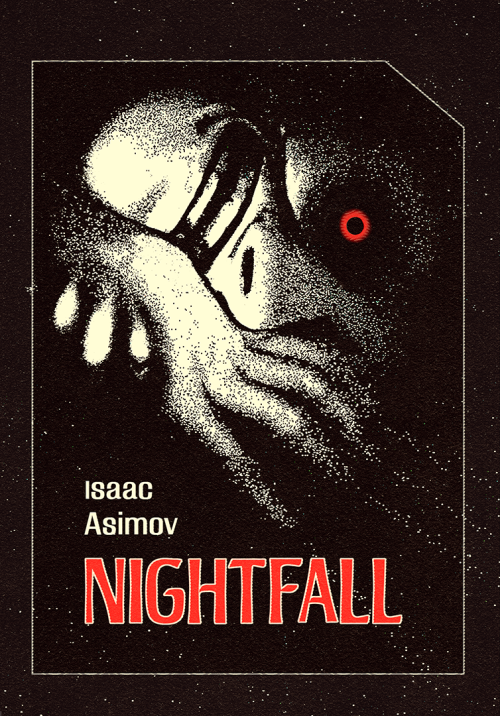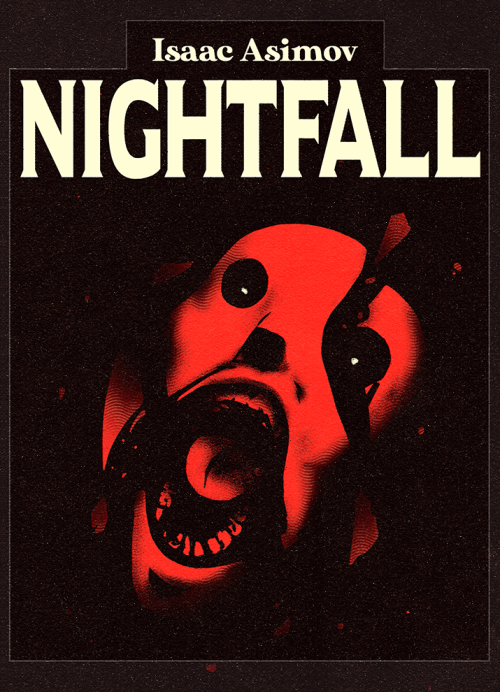NGC 4590 (M68) Globular Cluster

NGC 4590 (M68) Globular Cluster
33,000 light years from the Earth, this globular cluster has an odd orbit around our galaxy, orbiting like a comet does around a star, and moving away as far as 100,000 light years from the centre.
It’s theorised that it’s likely a captured cluster, and appears to be undergoing core collapse, where the gravitational influence of the entire cluster bares down at the centre and causes black holes and dense stars to slowly migrate towards the centre, much as our own galaxy has the same mechanism creating the central black hole.
More Posts from Starry-shores and Others
Eclipsing Suns
I can’t remember which novel JR said influenced the world of S6, but I was recently reminded of Asimov’s Nightfall and wonder whether its eclipse narrative might have some bearing on the plot …
[Spoilers for Nightfall ahead – highly recommend you read the story (it’s short!)]
For anyone not familiar, Nightfall is set on a planet with six suns - enough suns that the planet never experiences darkness. Every 2000 years or so, the suns and the planet’s moon align just so, and an eclipse occurs. And every 2000 years, something cataclysmic occurs that ends civilization. The only records of the event are embedded in the mythology of an ancient cult’s scripture.
During one of these cycles, a team of astronomers and psychologists collaborate with the cult, and together determine that they are weeks away from the next eclipse. The scientists lock their loved ones away in a bunker and prepare equipment to document the eclipse, which they do not believe they will survive. (Having never experienced nighttime, they have a pathological fear of the dark. Even more concerning, however, is the threat of the Stars mentioned in ancient scripture, for these have the power to burn cities and drive men to madness.)
And when the eclipse occurs and people see the night sky for the first time in two thousand years, they are struck with terror and knowledge of their insignificance, and all the world over, people set their cities on fire to blot out the stars’ truth and the horror of the long night.
… What little we do know about S6 reminds me of this. Like Clarke and co., these scientists attempt to learn what happened to a lost civilization (Eligius III) while hampered by a cult-like organization (Second Dawn? Wonkru? Whoever now inhabits the planet?) that has attached mythological meaning to the natural phenomenon of the eclipse. JR has said that something crucial happens when the suns eclipse, and though suns eclipsing themselves does not create total darkness, as here, we can guess that there will be psychological ramifications attached to it.
oh my god. apparently during the making of the Voyager golden record they had to fly the recorder by commercial airlines to add some material onto the record last minute and they booked a seat for it under the name of Mr. Equipment







on stories, leaving a mark, and wanting to be remembered
1. Jack Rackham in Black Sails s04e10 2. John Berger, And Our Faces, My Heart, Brief as Photos. 3. Carl Sagan on Voyager’s Golden Record 4. Ada Limón, During the Impossible Age of Everyone. 5. Paleolithic handprints in Cueva de las Manos, Argentina 6. Sappho, If Not, Winter (translated by Anne Carson)

Hubble Observes Infant Stars in Nearby Galaxy by NASA Hubble


Book cover assignment for class, we had three short scifi stories to choose from and I chose Isaac Asimov’s “Nightfall”. 🔴🌌

Daphnis and the Rings of Saturn : What’s happening to the rings of Saturn? A little moon making big waves. The moon is 8-kilometer Daphnis and it is making waves in the Keeler Gap of Saturn’s rings using just its gravity – as it bobs up and down, in and out. The featured image is a colored and more detailed version of a previously released images taken in 2017 by the robotic Cassini spacecraft during one of its Grand Finale orbits. Daphnis can be seen on the far right, sporting ridges likely accumulated from ring particles. Daphnis was discovered in Cassini images in 2005 and raised mounds of ring particles so high in 2009 – during Saturn’s equinox when the ring plane pointed directly at the Sun – that they cast notable shadows. via NASA
Okay, the title of The Atlantic’s article might be a little click-bait-y. But the discovery is truly remarkable. A new bone has been analyzed from the already-famous cave in Russia, and it belonged to, per DNA analysis, the daughter of a Neanderthal mother and a Denisovan father.

Dusty Stars Of Orion
-
 infiniteproxy reblogged this · 3 years ago
infiniteproxy reblogged this · 3 years ago -
 starry-shores reblogged this · 3 years ago
starry-shores reblogged this · 3 years ago -
 an-abyss-called-life liked this · 3 years ago
an-abyss-called-life liked this · 3 years ago -
 wachsurfer2018 liked this · 4 years ago
wachsurfer2018 liked this · 4 years ago -
 mariaioannatrzpl-blog liked this · 4 years ago
mariaioannatrzpl-blog liked this · 4 years ago -
 strangerindelight liked this · 4 years ago
strangerindelight liked this · 4 years ago -
 nthlcrvlh liked this · 4 years ago
nthlcrvlh liked this · 4 years ago -
 lesneuxx reblogged this · 4 years ago
lesneuxx reblogged this · 4 years ago -
 alazarinmobius liked this · 4 years ago
alazarinmobius liked this · 4 years ago -
 mataiodragon reblogged this · 4 years ago
mataiodragon reblogged this · 4 years ago -
 kate-is-here-to-vibe liked this · 4 years ago
kate-is-here-to-vibe liked this · 4 years ago -
 awesomeness27 liked this · 4 years ago
awesomeness27 liked this · 4 years ago -
 kholod87 liked this · 4 years ago
kholod87 liked this · 4 years ago -
 unstableblackturtle liked this · 4 years ago
unstableblackturtle liked this · 4 years ago -
 alex-roy-india liked this · 4 years ago
alex-roy-india liked this · 4 years ago -
 yarnandyarrow reblogged this · 4 years ago
yarnandyarrow reblogged this · 4 years ago -
 thegirlwholovedblackholes liked this · 4 years ago
thegirlwholovedblackholes liked this · 4 years ago -
 astras-midnight-thoughts liked this · 4 years ago
astras-midnight-thoughts liked this · 4 years ago -
 xstellinaaax liked this · 4 years ago
xstellinaaax liked this · 4 years ago -
 bloodwingblade liked this · 4 years ago
bloodwingblade liked this · 4 years ago -
 inevitablyunstable liked this · 4 years ago
inevitablyunstable liked this · 4 years ago -
 archdemoness liked this · 4 years ago
archdemoness liked this · 4 years ago -
 weidenbruck liked this · 4 years ago
weidenbruck liked this · 4 years ago -
 sorakitsune reblogged this · 4 years ago
sorakitsune reblogged this · 4 years ago -
 sorakitsune liked this · 4 years ago
sorakitsune liked this · 4 years ago -
 lizziecmoon liked this · 4 years ago
lizziecmoon liked this · 4 years ago -
 miridiums reblogged this · 4 years ago
miridiums reblogged this · 4 years ago -
 futurexpress liked this · 4 years ago
futurexpress liked this · 4 years ago -
 anonymous428315516723114213 liked this · 4 years ago
anonymous428315516723114213 liked this · 4 years ago -
 lanafeline liked this · 4 years ago
lanafeline liked this · 4 years ago -
 nlockett reblogged this · 4 years ago
nlockett reblogged this · 4 years ago -
 nlockett liked this · 4 years ago
nlockett liked this · 4 years ago -
 spacetimewithstuartgary reblogged this · 4 years ago
spacetimewithstuartgary reblogged this · 4 years ago -
 spacetimewithstuartgary liked this · 4 years ago
spacetimewithstuartgary liked this · 4 years ago -
 diewalkure liked this · 4 years ago
diewalkure liked this · 4 years ago -
 mataiodragon liked this · 4 years ago
mataiodragon liked this · 4 years ago -
 i-fear-the-normal liked this · 4 years ago
i-fear-the-normal liked this · 4 years ago -
 turnedtoamonster liked this · 4 years ago
turnedtoamonster liked this · 4 years ago -
 has-anyone-seen-my-fandoms reblogged this · 4 years ago
has-anyone-seen-my-fandoms reblogged this · 4 years ago -
 has-anyone-seen-my-fandoms liked this · 4 years ago
has-anyone-seen-my-fandoms liked this · 4 years ago -
 mebitek-official liked this · 4 years ago
mebitek-official liked this · 4 years ago -
 jabberding0 liked this · 4 years ago
jabberding0 liked this · 4 years ago -
 dareleft liked this · 4 years ago
dareleft liked this · 4 years ago -
 thomasbrisenio liked this · 4 years ago
thomasbrisenio liked this · 4 years ago

Amateur astronomer, owns a telescope. This is a side blog to satiate my science-y cravings! I haven't yet mustered the courage to put up my personal astro-stuff here. Main blog : @an-abyss-called-life
212 posts

